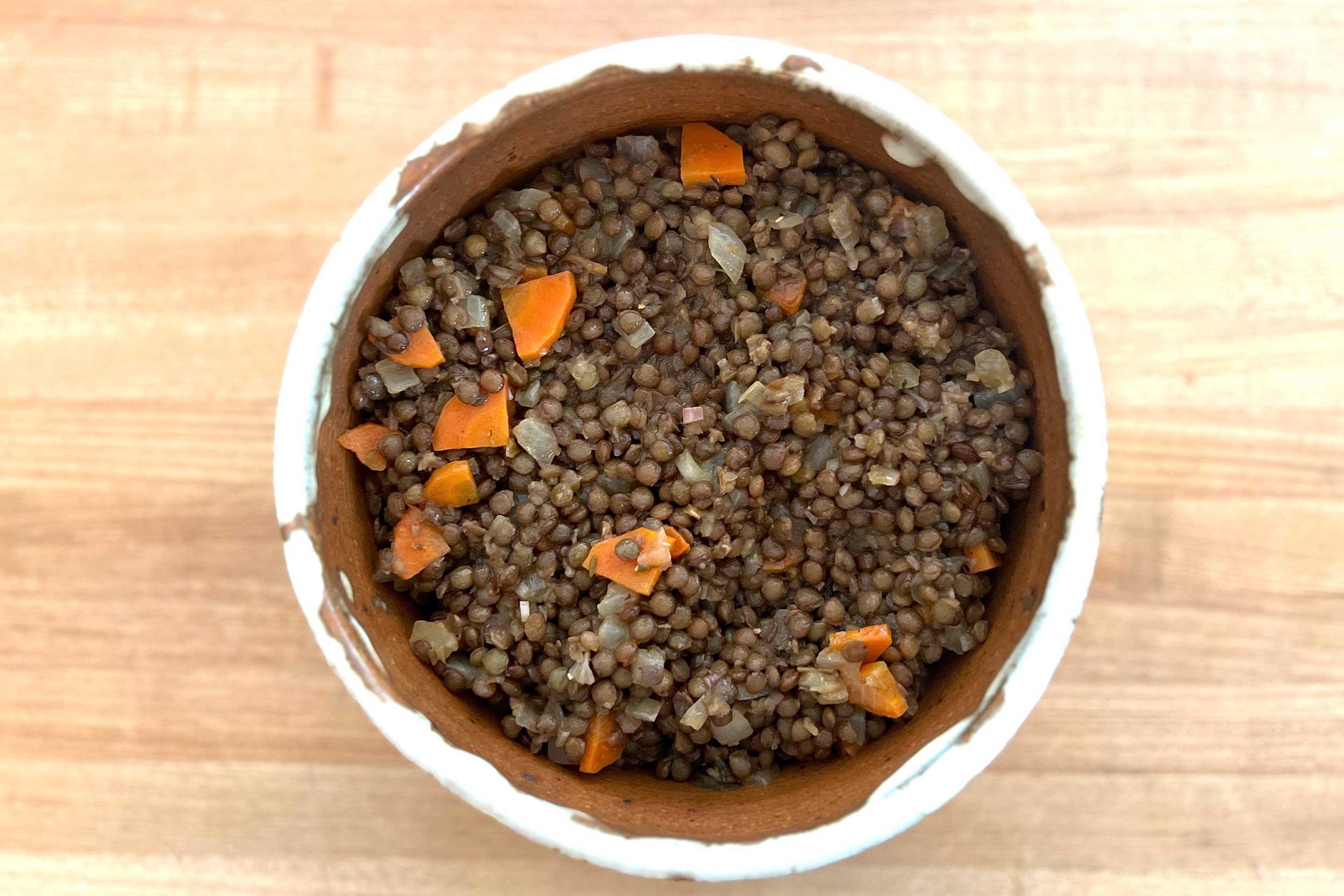This story is part of On Repeat, a series in which we ask top chefs, cookbook authors, and other famous foodies about the dishes they just can’t quit.
You don’t hear much from me because I try to stay out of the way, but I started one5c, the company that makes Cool Beans. I am the Bean’s biggest fan, which means I’m pretty nervous about polluting these pixels with my own discount food thoughts. Fortunately, On Repeat is an exercise in highlighting other people’s brilliance; I can do that all day.
I’ve been avoiding meat for a few years now, and one of my go-to dishes comes from Chez Panisse alum David Lebovitz, who, despite being a pastry chef by trade, makes some of my favorite savory recipes—including this one. It’s easy. It’s cheap. It’s healthy. It’s the no-brainer in the no-brainer aisle of the supermarket of my mind. Lebovitz calls it cheap caviar. You probably know it as French lentil salad. It’s a delicious, year-round meal that shines from side dish to center stage.
Why I love it
Two words: pantry superstar. Once you start stocking lentils du Puy (or their American cousins), you’ll realize that you’ve always got the ingredients on hand to whip this up. Who doesn’t have carrots, onions, mustard, and vinegar? And shallots are short on cost and long on shelf life, so if you buy some the next time you push your cart by their bin, you’re locked in.
Then there’s the nutritional aspect, which we plant-forward folk can’t ignore. They may not be a complete protein like groats, but lentils bring plenty of power to the party—plus fiber and iron. Throw a fried egg on top, and you’ve got a filling meal with all your aminos.
But this is a story about flavor. Every time I make a French lentil salad (which is often), either my wife or I will say something like, “Why don’t we eat this more?” It’s great on its own but also complements an astonishing variety of other dishes, from bright greens to hearty venison. And the French lentils themselves are a nearly perfect pulse, with a grapelike chew that yields a creamy interior. Eat this salad warm or cold—or, my favorite, at room temperature—and you’ll be a convert for life. Pinky swear.
What I’ve changed
I pretend this recipe doesn’t call for fennel. Even Lebovitz says it’s optional, and I think the salad tastes better without the bulb. Use it or don’t—you’ll be happy. This unfussy formula rewards you for using good ingredients but doesn’t punish you for going off-piste. Fresh thyme? Sure, if you’ve got it; but the spice jar’s just fine. No shallots in the house? No sweat; any finely minced onion works in the vinaigrette. In place of sherry or red wine vinegar, I’ve subbed white wine, champagne, even a home-brewed apple cider vin I make from cores and peels. I’ve used corner-store olive oil and my finest extra-virgin. It’s always good.
The only thing you really shouldn’t skimp on is the mustard. Use the best smooth Dijon you can find, and quadruple Lebovitz’s recommended dose. This boosts the salad’s tanginess and soups up one of cooking’s great aroma moments. When you combine the warm, sautéed veggies and cooked lentils with the vinaigrette, the ingredients throw an olfactory uppercut I look forward to every time I cook this. Which is about to happen right now. See ya!
What else I’m into right now
Soft beans. During the pandemic, I bought a bunker’s worth of black beans (*cough* 20 pounds *cough*), and what I’ve got left are very old, and never seem to get fully cooked. This weekend I resolved to turn these stragglers into something good instead of flavored pebbles that freeload in my pantry. I read on the Bean Institute (a trade group for bean farmers) that baking soda can help break down the pectin in legumes, which softens them faster. I added a teaspoon to a slow-rolling pot of Mexican-style frijoles, and they came out smooth as a top spinning on marble. Bonus: As you might remember from an early edition of Cool Beans, baking-soda’d beans make you fart less. Everybody wins.
Onigiri. In the space of a week, my kid decided she loved both rice and seaweed, which made school lunches a lot more interesting. If you’ve ever spent time in Japan, you probably know that rice + seaweed is a literal recipe for onigiri, the triangular rice balls that grace every Japanese schoolkid’s bento. You can stuff them with anything from sour plums to salmon, and adorn them with sesame seeds, a soy glaze, and more. They’re easy enough to shape by hand, but I picked up a steel (i.e., not plastic) onigiri mold so the kiddo can join the fun too.
Fancy vegan cheese videos. Note that I said videos. I have neither the time nor intention to make the delicious-looking nondairy camembert or roquefort that vegan super chef Tomaso Mannu crafts, but that doesn’t mean I don’t love watching him do it. He turns nuts and mold cultures into plant-based cheeses that look every bit as delicious as the milk-made stuff that haunts my dreams.

